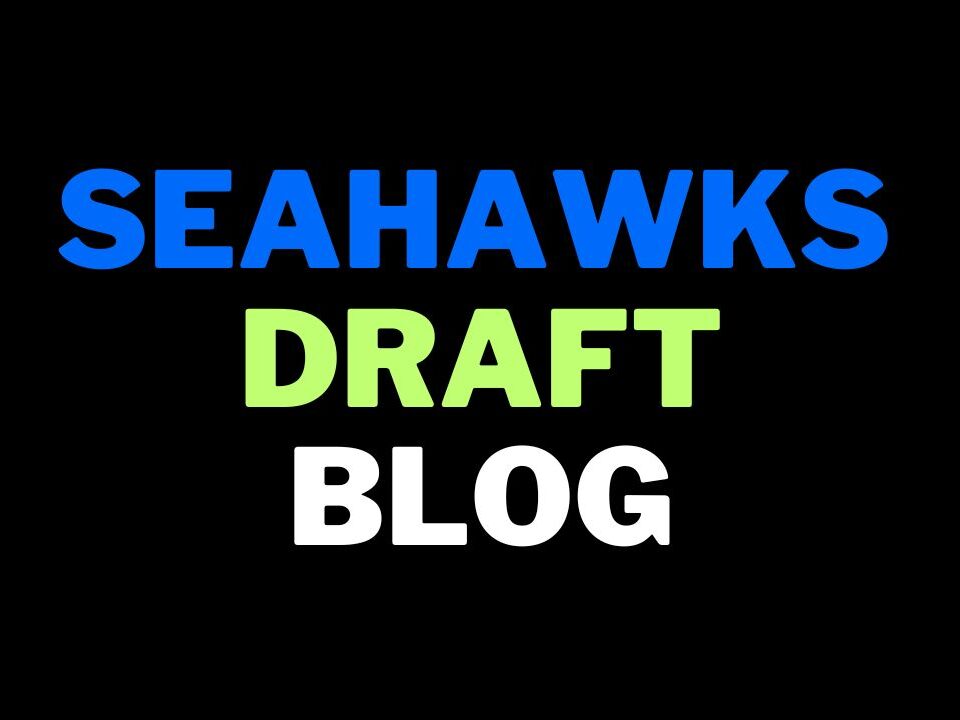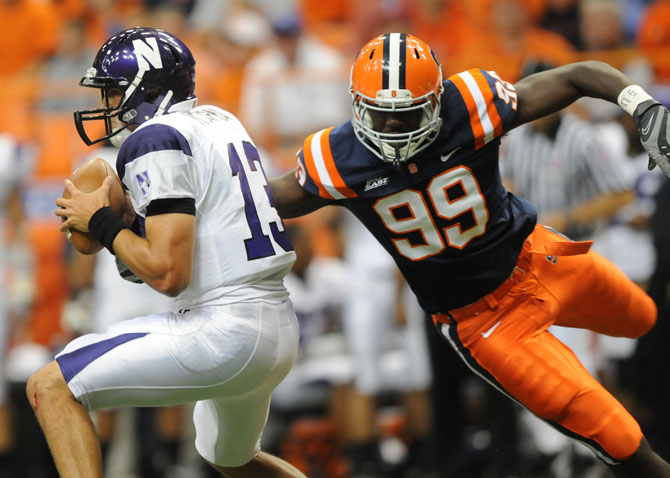
Boise State's Doug Martin could be an option for Seattle in round two
This week’s projection is based on information accumulated over the last two weeks and continued tape observation. This mock best describes how I see things unfolding after the Senior Bowl and building up to the combine. Some of the picks will go against on my own personal grades, but I want to put down a mock I can return to after the combine to see how things have changed as we move closer to April 26th. For that reason, I’ve also included a second round to this week’s projection.
I want to highlight the decision to have Minnesota take Robert Griffin III with the #3 overall pick. Last year, the Vikings spent a high first rounder on Christian Ponder and many people will disagree strongly with the suggestion they would draft another quarterback in round one this year.
For starters, I think Minnesota’s situation has changed significantly in the last twelve months. When Brett Favre was quarterback in 2009, the Vikings came within a drive of the Super Bowl. They somehow (desperately) managed to convince an injured Favre to return in 2010 and the result was a bit of a mess. I firmly believe the Vikings thought they had a roster good enough to compete if they could sort out their quarterback situation. They drafted Ponder with the #12 pick last April, then traded for Donovan McNabb to be the bridge. During the 2011 season, Minnesota surely realised they weren’t so close to competing after all. They have an old and bad offensive line, they have no secondary and even the pass rush is looking long in the tooth. They lost Sidney Rice and became too dependant on Percy Harvin. Adrian Peterson was left to carry the offense and he ended the year with a serious knee injury.
Having been so close to the Super Bowl, two seasons later the Vikings are pretty much back at square one. They need to rebuild.
Really this situation isn’t too different to the one facing Carolina twelve months ago. Like the Vikings, in the space of two years the Panthers went from NFC challenger to picking very early in round one. When the Panthers drafted Jimmy Clausen with their first selection in 2010, they had greater expectations for the rest of their roster. When it fell apart to the extent they were the worst team in the NFL, they knew they had to start over. Faced with the chance to draft a building block, Carolina took Cam Newton first overall and Clausen became an after-though. Sure, Ponder was a much higher pick – but the situation is very similar. Two years removed from being legitimate NFC challengers, the Vikings are picking 3rd overall and they have a chance to draft their Cam Newton.
You could argue it’s the team’s duty to build around Ponder and improve the offensive line, find him another receiver and piece together the defense. But here’s the thing: If Minnesota were picking first overall, would they draft Andrew Luck? Of course they would. Sure, they might see what they can get in a trade along the way – but like pretty much every team in the league they’d draft the big prize available at #1 this year. So if they’re willing to move past Ponder for Luck, would they do the same for Griffin III?
Think about it – Minnesota needs an icon. Adrian Peterson may never be the same again after his injury, so what does that leave you with? If Christian Ponder reaches his peak, the best he can hope to be is Chad Pennington. Is that really what you want to build around? Instead, you could have Robert Griffin III. Start Ponder for a year or two as the bridge and take your lumps. Build around RGIII and give him the time to learn a pro-style offense. If Ponder develops in that time – superb! You have the makings of a nice trade with another team who needs a quarterback. If not, bring on the RGIII era.
As the 12th pick last April, Ponder’s salary is just $10.5m on a four year contract. Tarvaris Jackson will earn around $8m for two years work in Seattle. There is no financial restriction here and Minnesota could easily accommodate both quarterbacks on their roster. Would it be different if they could draft a left tackle with elite potential such as Matt Kalil? Perhaps, but it’s almost certain St. Louis will draft the USC prospect if they can’t manufacture a trade with someone moving up for Griffin. Nothing is a guarantee of course, but I’m led to believe there’s a feeling among some sections of the league that Griffin III won’t get out of the top three picks. This maybe justifies why St. Louis are actually being touted as a logical trade partner.
It wouldn’t be a major stretch if the Vikings’ draft board read: 1) Luck 2) Kalil 3) Griffin III. You don’t often get the chance to draft that early so you need to make those picks count. Are you really going to pass on a special talent at quarterback for Christian Ponder’s sake? If Griffin III is set to be taken in the top three picks, Seahawks fans hoping for a deal can forget about it. The Rams aren’t going to trade with Seattle and if the Vikings do like RGIII, it’ll cost a kings ransom to move up. It appears defense will be on the agenda for the ‘Hawks at #11 or #12 unless a talented offensive player like Trent Richardson suffers an unlikely fall.
Updated first round
 |
 |
#1 Andrew Luck (QB, Stanford)
The Colts are cleaning house to make room for the Andrew Luck era. They might as well start talking about a contract now. |
 |
 |
#2 Matt Kalil (OT, USC)
The Rams have to take Kalil, he’s too good to pass up. There’s enough depth at receiver to wait until round two. |
 |
 |
#3 Robert Griffin III (QB, Baylor)
If Minnesota would’ve been prepared to take Andrew Luck at #1, why wouldn’t they consider taking RGIII here?. |
 |
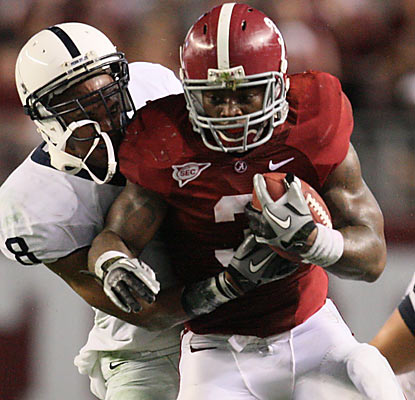 |
#4 Trent Richardson (RB, Alabama)
Elite playmaking talent who will have an instant impact. Cleveland may draft Richardson here even if Griffin’s still on the board. |
 |
 |
#5 Morris Claiborne (CB, LSU)
You have to believe Greg Schiano would love to draft Trent Richardson. Cornerback is also a need. |
 |
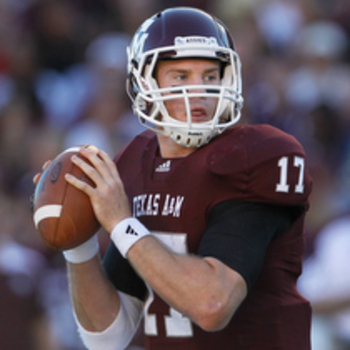 |
#6 Ryan Tannehill (QB, Texas A&M)
This would be a foolish reach but Shanahan wants his guy. If Tannehill really is going to go in the top-15 as speculated, Washington is the obvious choice. |
 |
 |
#7 Quinton Coples (DE, North Carolina)
He’s an enigma, but also a player some teams will love to take a chance on. Expect Jacksonville to sign receivers during free agency. |
 |
 |
#8 Devon Still (DT, Penn State)
Carolina want to have lots of different defensive looks and Still is scheme versatile. This is a big need for the Panthers. |
 |
 |
#9 Justin Blackmon (WR, Oklahoma State)
Green Bay has a lot of talented receivers, Miami has Brandon Marshall. If Joe Philbin goes back for Matt Flynn, he’ll need targets. |
 |
 |
#10 Riley Reiff (OT, Iowa)
The Bills would be in a good spot here with both Reiff and Jonathan Martin on the board. Pick your poison. |
 |
 |
#11 Courtney Upshaw (DE, Alabama)
Upshaw won’t blow up the combine and that could put him in range for the Seahawks. |
 |
 |
#12 Jonathan Martin (OT, Stanford)
The Chiefs could do with boosting their offensive line. They’d have the option to play Martin at left or right tackle. |
 |
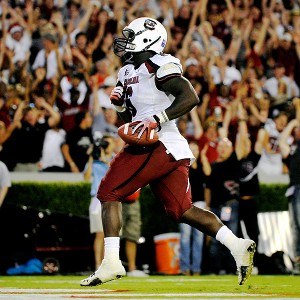 |
#13 Melvin Ingram (DE, South Carolina)
With two offensive tackles leaving the board quickly, it could force Arizona to go for another need – pass rusher. |
 |
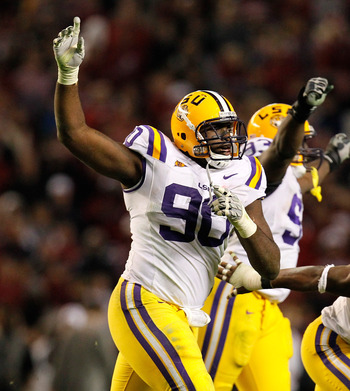 |
#14 Michael Brockers (DT, LSU)
Most people expect Dallas to draft for their secondary in round one, but the options aren’t great – unlike Brockers. |
 |
 |
#15 Zach Brown (LB, North Carolina)
Andy Reid doesn’t like drafting linebackers, but he might have to. Zach Brown will start to rise up the boards very soon. |
 |
 |
#16 Michael Floyd (WR, Notre Dame)
I’m not a big fan but the Jets need a receiver and Floyd just looks like a Rex Ryan type of pick. |
 |
 |
#17 David DeCastro (OG, Stanford)
Slightly over rated, a technician who looks great on the move but lacks elite power at the point of attack. |
 |
 |
#18 Mike Adams (OT, Ohio State)
He was practically unstoppable at the Senior Bowl and teams will be looking at Adams as a potential blind side blocker. |
 |
 |
#19 Kendall Wright (WR, Baylor)
Electric receiver who would quickly become Jay Cutler’s BFF. Capable of having a big impact quickly. |
 |
 |
#20 Whitney Mercilus (DE, Illinois)
They need to improve their edge rush and Mercilus led the nation for sacks. A hard player to work out. |
 |
 |
#21 Mark Barron (S, Alabama)
Safety’s with Barron’s range are difficult to find and his 2011 performance warrants top-25 consideration. |
 |
 |
#22 Dwight Jones (WR, North Carolina)
Having added a running back, they now add possibly the best receiver in the draft class. Quarterback later on or in free agency. |
 |
 |
#23 Cordy Glenn (OT, Georgia)
A senior bowl to remember will help promote his stock, but he got better and better as the season went on for Georgia. |
 |
 |
#24 Kelechi Osemele (OG, Iowa State)
Played left tackle at Iowa State but will kick inside to guard at the next level. I really like this guy. |
 |
 |
#25 Luke Kuelchy (LB, Boston College)
He’s under sized but what a tackler – he’ll get close to 100 tackles in year one. Has some limitations and he’s no pass rusher. |
 |
 |
#26 Fletcher Cox (DT, Mississippi State)
Imagine JJ Watt and Fletcher Cox on the same defensive line. If they lose Mario Williams, they need to find a pass-rush replacement. |
 |
 |
#27 Peter Konz (C, Wisconsin)
Top-end interior lineman who could be the best in this class. Stuck out on a talented Badgers line and no surprise he turned pro. |
 |
 |
#28 Dre Kirkpatrick (CB, Alabama)
Great in run support but not so much in coverage. Green Bay would get value here but Kirkpatrick has a lot to work on. |
 |
 |
#29 Mohamed Sanu (WR, Rutgers)
Sanu can line up anywhere and make plays. San Francisco use a lot of gimmicks and need a sure-handed catcher. |
 |
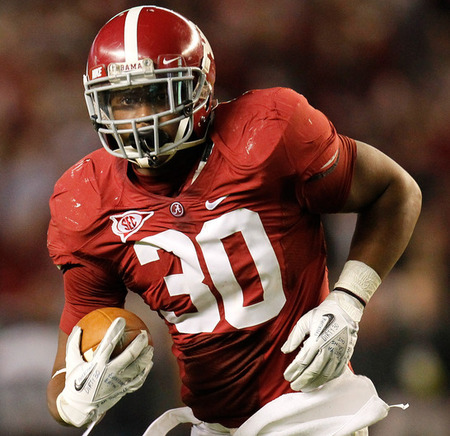 |
#30 Dont’a Hightower (LB, Alabama)
A Ravens type of player if ever you saw one. He’s stout against the run but makes enough plays on the move to go here. |
 |
 |
#31 Sean Spence (LB, Miami)
Underrated linebacker who makes up for great size with speed, instinct, tackling and elite recognition skills. |
 |
 |
#32 Janoris Jenkins (CB, North Alabama)
A top-ten talent on the field, but an UDFA off it. New England are willing to take on projects like this (see: Ryan Mallett). |
Second round
#33 St. Louis – Juron Criner (WR, Arizona)
The Rams make use of the depth at receiver this year and find Sam Bradford a new #1 target.
#34 Indianapolis – Alameda Ta’amu (DT, Washington)
In moving to the 3-4, the Colts need a nose tackle. Ta’amu could go earlier than this.
#35 Minnesota – Reuben Randle (WR, LSU)
Without a great offensive lineman or cornerback available here, the Vikings checkdown and go receiver.
#36 Tampa Bay – Chris Polk (RB, Washington)
He’s not Trent Richardson, but he’s the kind of physical runner the Bucs will look for.
#37 Cleveland – Andre Branch (DE, Clemson)
A steal for the Browns who are slowly building a top young defensive line.
#38 Jacksonville – Vinny Curry (DE, Marshall)
The Jaguars double dip at defensive end and makeover their pass rush having added Quinton Coples earlier.
#39 Washington – Alshon Jeffery (WR, South Carolina)
Getting a big target for their new quarterback would be a wise idea and Jeffery is good value here.
#40 Carolina – Brandon Thompson (DT, Clemson)
Like Jacksonville, Carolina double-up on a big area of need. Thompson + Stills = scary.
#41 Buffalo – Nick Perry (DE, USC)
The next best pass rusher on the board having added to the offensive line in round one.
#42 Miami – Cam Johnson (DE, Virginia)
The Dolphins also need to improve their edge rush and take this rising senior with a lot of potential.
#43 Seattle – Doug Martin (RB, Boise State)
The Seahawks know their offense is based around the run and they need to make sure they have strong depth at running back.
#44 Kansas City – Dontari Poe (DT, Memphis)
Nose tackle is a position of great value these days and the Chiefs make sure they get a young one here.
#45 Dallas – Jayron Hosley (CB, Virginia Tech)
Just a great playmaker who I suspect Jerry Jones will rate highly. He gambles, but he’s also exciting.
#46 Philadelphia – Brock Osweiler (QB, Arizona State)
The Eagles always make sure they’re prepared at quarterback and Osweiler is underrated.
#47 New York Jets – Jared Crick (DE, Nebraska)
This would be excellent value for a player with lots of pass-rushing ability.
#48 New England – Joe Adams (WR, Arkansas)
Whoever drafts this guy won’t be sorry.
#49 San Diego – Shea McClellin (DE, Boise State)
3-4 teams looking for an edge rusher will give McClellin strong consideration in round two.
#50 Chicago – Jerel Worthy (DT, Michigan State)
A player who lurches between dominant and irrelevant, but it’s worth trying to keep the lights on.
#51 Philadelphia – Lavonte David (LB, Nebraska)
Speedy linebacker who’s gaining momentum. Will provide some pass rushing threat.
#52 Tennessee Mike Martin (DT, Michigan)
The tape says 100% effort guy with a lot of talent and teams will want him on their roster.
#53 Cincinnati – Lamar Miller (RB, Miami)
This would possibly be the steal of the draft.
#54 Detroit – Chandler Jones (DE, Syracuse)
He’s raw and lacks technique, but there’s a bit of JPP about his style.
#55 Atlanta Coby Fleener (TE, Stanford)
The heir apparent to Tony Gonzalez?
#56 Pittsburgh – Bobby Wagner (LB, Utah State)
He looked good enough in the Senior Bowl to make it into the back-end of round two.
#57 Denver – David Wilson (RB, Virginia Tech)
A running back with a lot of speed but doesn’t always make the best decisions.
#58 Houston Josh Chapman (DT, Alabama)
The unsung hero of the ‘Bama defense. He played really well in 2011.
#59 New Orleans – Stephen Hill (WR, Georgia Tech)
Huge potential in terms of physical quality and ability to catch the ball.
#60 Green Bay – Kirk Cousins (QB, Michigan State)
The Packers are always one step ahead of the curve when it comes to quarterbacks.
#61 Baltimore – Alfonzo Dennard (DB, Nebraska)
I’ve always had him in this range and don’t buy the first round talk.
#62 San Francisco – Orson Charles (TE, Georgia)
The Niners can run a lot of dangerous 2TE sets if they draft this guy.
#63 New York Giants – Kendall Reyes (DT, Connecticut)
He can do a back flip. He is 299lbs.
#64 New England Ronnell Lewis (LB, Oklahoma)
I like Lewis, he’s just not spectacular in any particular way. Just a good all-round skill set.
Just missed the cut: Vontaze Burfict (LB, Arizona State), Brandon Boykin (CB, Georgia), Harrison Smith (S, Notre Dame), Logan Harrell (DT, Fresno State), Dwayne Allen (TE, Clemson), Brandon Washington (G, Miami), Chase Minnifield (CB, Virginia), Nicolas Jean-Baptiste (DT, Baylor).
